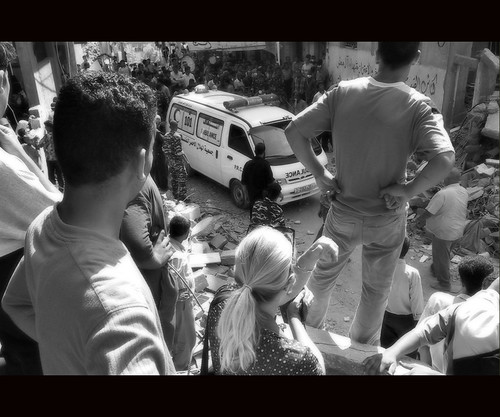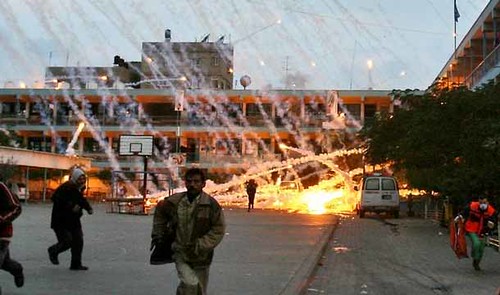Gazas liv i historiebøkene
For litt under et år siden mottok jeg denne meldingen, videresendt fra Mads Gilbert, norsk lege på Gazastripen:
I dag, på ettårsdagen for angrepet på Gaza, "Operation Cast Lead" tikket denne meldingen inn, videresendt fra Gilbert:De bombet det sentrale grønnsaksmarkedet i Gaza by for to timer siden. 80 skadde, 20 drept, alt kom hit til Shifa. Hades! Vi vasser i død, blod og amputater. Masse barn, gravid kvinne. Jeg har aldri opplevd noe så fryktelig. Nå hører vi tanks. Fortell videre, rop videre. Alt. GJØR NOE! GJØR MER! Vi lever i historieboka nå, alle!
Mads G. 03.01.09 - 13:50 - Gaza, Palestina
Jeg har også gått og tenkt mye på Gaza de siste par månedene. Jeg har tilfeldigvis kommet til å lese meg opp på Gazabombingen i ukene som har gått, og jeg har gjenopplevd den følelsen jeg hadde mens det grusomme sto på.Ikke glem Gaza! Nådeløs blokade og utsulting. Palestinske kvinner, barn og gamle lider, menn likvideres. Utbomba boliger, skoler og gudshus fortsatt i ruiner. Ingen materialer slippes inn. Siste livsnerve kuttes når tunnellene sperres. Israel bryter ustraffet krigens lover. Vesten lukker øynene. USA lar Israel diktere. Storting og regjering investerer kynisk våre oljepenger i Israel. Dette skal ikke fortsette! Fortell det videre, rop det videre! Alle må gjøre noe, gjøre mer! Vi lever fortsatt i historieboka.
Hilsen Mads G. 27.12.09
Den stemningen jeg husker best fra de tre ukene der var en irriterende følelse i brystet, nesten som halsbrann. Det var sinne. Den satte seg i overkroppen og halsen, helt fysisk. Som jeg sa til min venn Trygve når det hadde stått på noen dager: "Nå må de få orden på dette. Jeg er ikke vant til å være sint så lenge."
Det er sant. Jeg er så å si aldri langsint. Men her gikk jeg i ukesvis og bar på et frustrert, overflommende raseri over det som skjedde. Og jeg er fortsatt rasende over det som skjedde. Jeg kan ikke forestille meg å leve under den formen for psykologisk terror over så lang tid når bare et par uker med fjernt, trygt raseri er nok til å rykke meg ut av min rytme.
Egentlig var jeg ikke så mye rasende over det som skjedde -- slike massakrer er så sjeldne som de burde være -- men dels over at slikt skal ikke skje blant akseptert medlemmer av det internasjonale samfunn og dels over den fullstendige impotensen av policyresponsen til tross for massiv folkelig støtte. Hadde Kongo-krigen eller Sudan vekket det samme engasjementet ville de konfliktene trolig ha sett helt annerledes ut.
Men det Gilbert sier om historiebøkene er like sant som det alltid har vært. Men nå er historiebøkene om Gazabombingen heldigvis begynt å komme ut: Goldstonerapporten kom ut i september i år. Den ble straks møtt med en storm av protester om dens disproporsjonalitet og favorisering av palestinerne.
I motsetning til de fleste som kritiserer rapporten har jeg faktisk lest den. Det tok meg to måneder å komme igjennom den (den er 600 A4-sider lang, sånn ca. tre-bind-i-Min kamp-lengde). Som jeg har nevnt et par ganger tidligere på bloggen her er den ikke det spøtt disproporsjonal. Å kalle den det er en fullstendig misforstått kritikk, som bunner i en elementær logisk og moralsk misforståelse.
Goldstonerapporten er en proporsjonal representasjon — av en grunnleggende disproporsjonal konflikt. Det er ikke sånn at alle parter skal fordømmes like mye når en part helt åpenbart er aggressoren. Det er ikke slik at Palestina skal fordømmes 1 enhet for hver enhet fordømmelse av Israel -- når Israel kan dokumenteres som overgriper.
Rapporten ble derfor også møtt med et hylekor av motstand, den ene motstanderen mer grunnløs enn den neste. Hele nettsteder er satt opp bare for å rakke ned på rapporten og Goldstone. Det er latterlig, som om den systematiske dokumentasjonen fra fagfolk skulle bli mindre klar bare fordi merkverdige ideologer kan rikke ved en observasjon her, en kommentar der. Goldstonerapportens styrke er dens systematikk, dens dokumentasjon av den samme typen av overgrep på en rekke forskjellige steder og tider.
Det som kommer entydig og klart fram i rapporten er et skandaløst og dypt umoralsk system av undertrykkelse, krigsforbrytelser og forakt for internasjonal lov. Det er en dokumentasjon av et angrep på ubevæpnete sivile med tunge våpen. På ødeleggelse på pur faen, utslettelsen av sivil infrastruktur: kyllingfarmer, melfabrikker, åkere moskeer og kloakkanlegg. Sivile som blir skutt ned på åpen gate til tross for at de helt åpenbart var ubevæpnete. FN-områder fulle av flyktninger som blir beskutt med fosfor i timesvis, til tross for at kontakt etableres med militæret.
Det er ingen andre ord for det enn forbrytelser mot menneskeheten, og det mener jeg i den juridiske forstand av det begrepet. De ansvarlige bør fengsles, dømmes og straffes. Og det å samarbeide med Israel i disse dager bør regnes som et tegn på dyp useriøsitet eller ren kynisme.
Det å forsvare Israels okkupasjon kan kanskje på et eller annet tidspunkt i historien ha vært et legitimt standpunkt med gode argumenter. Den tiden er for lengst forbi. Israel-"venner" forlater sin egen grunnleggende moralske legitimitet. Det moralske kompasset er lagt vekk til fordel for en politisk ensidighet som får folk drept.
Gazabombingen og Goldstonerapporten er den siste tesen i et langt argument, hvis konklusjon er ubestridelig: Det å støtte Israels okkupasjonspolitikk idag er umoralsk. Det å støtte invasjonen i Gaza er å støtte forbrytere og massemordere.
Oppdatering I: Jeg er for trøtt til å finne alle de interessante lenkene, men Ali Esbati har en flott samling lenker til videre lesning og ytterligere problematisering av Gazaangrepet.
Oppdatering II: Erik Fosse, som var på Gaza samtidig med Gilbert, blir intervjuet i Dagsavisen [edit: av NTB] om Gaza:
– Andre krigsområder følges opp, det jobbes for å få befolkningen på fote igjen. I Gaza har det ikke skjedd noe. Verden står og ser på, alt er på vent. Imens fortsetter Israel å herse med palestinerne. Det er en skam, sier han.
Oppdatering III: Dagsavisen har en god dekning av Gaza. Min gamle kollega Espen Løkeland-Stai har også et intervju med Mads Gilbert, her.
Les også leder i Dagsavisen, her, og sterk sak av Mohammed Omer, her.– Ingenting er bygget opp. Gaza ligger i grus og israelerne har en helt bevisst politikk på å skru krana så hardt igjen at folk flest ikke dør av det, men slik at de likevel lider. Det vi har sett det siste året er en omfattende kollektiv avstraffelse, som er forbudt etter Genèvekonvensjonene, sier Gilbert.
Det er ifølge Gilbert et alvorlig nederlag for Vestens humanistiske plattform: At menneskerettighetene er globale og for alle.
– Palestinerne er fratatt menneskerettighetene, de er ikke inkludert. De er «de andre», «undermennesker», jihadister, terrorister, kall dem hva du vil, du kan gjøre hva du vil med dem, og det er nettopp det Israel gjør, uten at verdenssamfunnet stanser dem. Det er dette som opprører meg mest, sier Gilbert, som denne høsten var tilbake i Gaza og møtte mange av dem han behandlet under krigen.
Les også min egen avis, Klassekampen. Sissel Henriksen skriver sak her, og flott leder fra Anders Horn, her.
Labels: crimes against humanity, gaza, goldstone, israeli-palestine conflict, mads gilbert, operation cast lead


.jpg)

